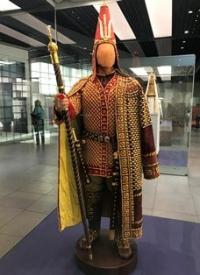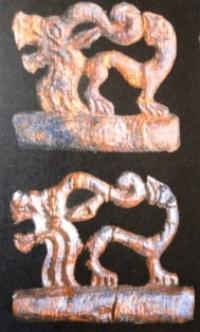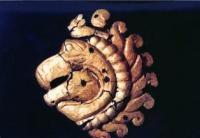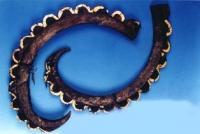You are here
Berel burial mounds.




The monuments of archeology in East-Kazakhstan region.
“If diversity is a source of wonder, its opposite - the ubiquitous condensation to some blandly amorphous and singulary generic modern culture that takes for granted an impoverished environment - is a source of dismay. There is, indeed, a fire burning over the earth, taking with it plants and animals, cultures, languages, ancient skills and visionary wisdom. Quelling this flame, and re-inventing the poetry of diversity is perhaps the most importent challenge of our times”
Wade Davis.
Day trip to Berel burial mounds.
The Berel burial site includes ap proximately 70 burial mounds of the various sizes covered by stone fills. The basis of it is the several parallel chains of the burial mounds extended from north-west to south-east. The "Bolshoy Berel burial mound" with a number of small burial mounds adjoining to it forms other unique group in this site.
The "Bolshoy Berel burial mound" was excavated by V.V.Radlov in 1865. Under the Bolshoy Berel burial mound, according to reports, there was the notable person accompanied by seventeen horses. Sixteen horses have been stacked in four lines (four horses in every line) behind the northern wall of the burial chamber.
One horse has been buried inside the frame near the barrel (Sorokin, 1969, p. 219). The Berel burial mounds are firstly interesting due to the following facts. Last decades of XX centuries in the adjacent region of Russian Altai the new monuments related directly to the "phenomenon of Pazyryk mummies" were opened.
It was mummified remains in the burial mound permafrost in the Ukok plateau located in 80 - 100 km from the Berel. As a matter of fact these finds have begun development of problems of ethnogenesis and ethnic history of ancient, medieval and modern peoples of the Central Asia at essentially new molecular-biological level.
In turn, this fact promoted to active introduction interdisciplinary approach to a technique of archaeological search. The Berel necropolis has been known to the broad public audience since 1998 due to the unique finds from one of the largest burial mound. Its diameter is 33.5 x 22.8 m; the maximum height of the stone fill is about 3 m.
The burial mound is the special construction erected for burial of the person, occupying the highest position in a social level of nomadic Scythian- Siberian tribes' society in the Altai sub- region. Its construction testifies about high building culture, architecture and complicated religious insights of people of the region in IV - III centuries ВС.
The main elevated part is a stone fill consisted of blocky and rubble-pebbled material without fine-grained filler carrying out role of the natural cold accumulator. A formation of permafrost has been occurring in this man- made porous thickness at positive average annual air temperatures.
In turn, presence of the burial mound permafrost has been provided good safety of all organic material during more than two thousand years. The basis of the burial mound is a platform that includes the large plates stacked on a flat area.
The platform has a little angle to the middle of the burial mound. It was determined after picking the stone fill. It testifies about natural sagging sandy clays under the large-tonnage stone loading. Not casually, the squeezed out clay filled in emptiness between stone plates in the bottom layers of stone fills that created false impression about application of clay solution at their stacking.
Edges of stone fills were fixed by the large plates stacked flatwise or on edge in several lines; then they were closed by the turfen layer containing small plates and pebble. The stone fill in the middle part consist of the plates with different size stacked in various position.
But their most part was in horizontal position. The top layer of stone fill includes small plates and pebble covering densely underlying stones. Moreover, constructions of various configurations, probably ritual purpose, were revealed too from the east and northeast of this burial mound.
For different reasons to subjects of art and amount of the found ornaments horse's decoration executed in the best traditions of so-called Scythian-Siberian animal style, the Berel burial mound No. 11 stands in one number with the most outstanding monuments created by ancient nomads of the Central Asia region in the first thousand ВС.
Many things have unique decorative design and peculiar interpretation of some animal's images or fantastic creatures. Due to burial mound permafrost the wooden, leather goods and felt covers on the horse's saddles with magnificent application on a theme of struggle with fantastic predators kept in a perfect condition.
The technique and ornamental design of the Kazakh tuskiy s (wall carpets) and syrmak (carpets covering the floor) are direct continuations of upper-mentioned felt products. The rich decorated leather saddles found in the burial mound are the most ancient ones in Kazakhstan.
Today paleobotanies have unique opportunity for to study of ancient flora due to containing grass in some horse's stomachs that were kept in the permafrost lens. The horse's bodies became objects of veterinary research (pathomorphological, parasitological, etc).
As a whole, the finds made in the Berel burial mound are not only unique but they represent outstanding discovery certainly will bring in the essential contribution to development of world culture and also will lift prestige of the Kazakhstan science.
Today the Berel burial mound in Kazakhstan is unique monument, research of which will allow not only to reconstruct shape of the inhabitants lived in the region 2.5 thousand years ago with the greatest reliability.
On the basis of research of mummified remains of the ancient people for the first time win be allocated paleogenetical markers of blood of the Kazakhs at biochemical and molecular-genetic levels.
Authority:
The book «Treasures of frozen barrows Kazakh Altai» А.П. Humpbacks, Z.S.Samashev, E.V.Seersky, Almaty, 2005
Photos by
Alexander Petrov.







